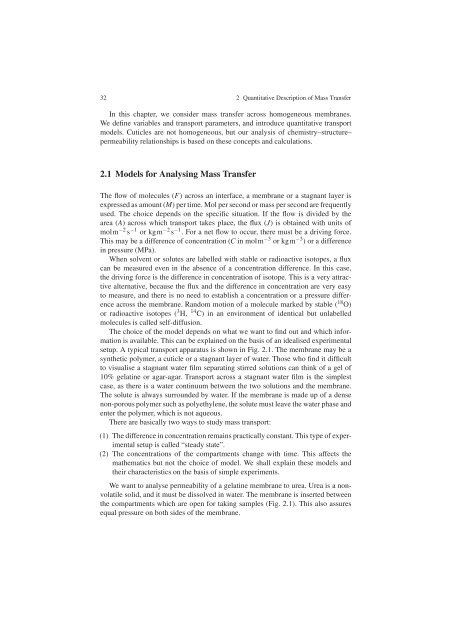Water and Solute Permeability of Plant Cuticles: Measurement and ...
Water and Solute Permeability of Plant Cuticles: Measurement and ...
Water and Solute Permeability of Plant Cuticles: Measurement and ...
You also want an ePaper? Increase the reach of your titles
YUMPU automatically turns print PDFs into web optimized ePapers that Google loves.
32 2 Quantitative Description <strong>of</strong> Mass Transfer<br />
In this chapter, we consider mass transfer across homogeneous membranes.<br />
We define variables <strong>and</strong> transport parameters, <strong>and</strong> introduce quantitative transport<br />
models. <strong>Cuticles</strong> are not homogeneous, but our analysis <strong>of</strong> chemistry–structure–<br />
permeability relationships is based on these concepts <strong>and</strong> calculations.<br />
2.1 Models for Analysing Mass Transfer<br />
The flow <strong>of</strong> molecules (F) across an interface, a membrane or a stagnant layer is<br />
expressed as amount (M) per time. Mol per second or mass per second are frequently<br />
used. The choice depends on the specific situation. If the flow is divided by the<br />
area (A) across which transport takes place, the flux (J) is obtained with units <strong>of</strong><br />
molm −2 s −1 or kgm −2 s −1 . For a net flow to occur, there must be a driving force.<br />
This may be a difference <strong>of</strong> concentration (C in molm −3 or kgm −3 ) or a difference<br />
in pressure (MPa).<br />
When solvent or solutes are labelled with stable or radioactive isotopes, a flux<br />
can be measured even in the absence <strong>of</strong> a concentration difference. In this case,<br />
the driving force is the difference in concentration <strong>of</strong> isotope. This is a very attractive<br />
alternative, because the flux <strong>and</strong> the difference in concentration are very easy<br />
to measure, <strong>and</strong> there is no need to establish a concentration or a pressure difference<br />
across the membrane. R<strong>and</strong>om motion <strong>of</strong> a molecule marked by stable ( 18 O)<br />
or radioactive isotopes ( 3 H, 14 C) in an environment <strong>of</strong> identical but unlabelled<br />
molecules is called self-diffusion.<br />
The choice <strong>of</strong> the model depends on what we want to find out <strong>and</strong> which information<br />
is available. This can be explained on the basis <strong>of</strong> an idealised experimental<br />
setup. A typical transport apparatus is shown in Fig. 2.1. The membrane may be a<br />
synthetic polymer, a cuticle or a stagnant layer <strong>of</strong> water. Those who find it difficult<br />
to visualise a stagnant water film separating stirred solutions can think <strong>of</strong> a gel <strong>of</strong><br />
10% gelatine or agar-agar. Transport across a stagnant water film is the simplest<br />
case, as there is a water continuum between the two solutions <strong>and</strong> the membrane.<br />
The solute is always surrounded by water. If the membrane is made up <strong>of</strong> a dense<br />
non-porous polymer such as polyethylene, the solute must leave the water phase <strong>and</strong><br />
enter the polymer, which is not aqueous.<br />
There are basically two ways to study mass transport:<br />
(1) The difference in concentration remains practically constant. This type <strong>of</strong> experimental<br />
setup is called “steady state”.<br />
(2) The concentrations <strong>of</strong> the compartments change with time. This affects the<br />
mathematics but not the choice <strong>of</strong> model. We shall explain these models <strong>and</strong><br />
their characteristics on the basis <strong>of</strong> simple experiments.<br />
We want to analyse permeability <strong>of</strong> a gelatine membrane to urea. Urea is a nonvolatile<br />
solid, <strong>and</strong> it must be dissolved in water. The membrane is inserted between<br />
the compartments which are open for taking samples (Fig. 2.1). This also assures<br />
equal pressure on both sides <strong>of</strong> the membrane.







